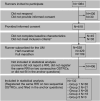Minimally important change and smallest detectable change of the OSTRC questionnaire in half- and full-marathon runners
- PMID: 33222326
- PMCID: PMC8252641
- DOI: 10.1111/sms.13885
Minimally important change and smallest detectable change of the OSTRC questionnaire in half- and full-marathon runners
Abstract
The purpose of this study was to evaluate the smallest detectable change (SDC), minimally important change (MIC), and factor structure of the Oslo Sports Trauma Research Center (OSTRC) questionnaire severity score in half- and full-marathon runners. Data came from a prospective cohort study, the SUcces Measurement and Monitoring Utrecht Marathon (SUMMUM) 2017 study. Two external anchors, the global rating of change (GRC) and global rating of limitations (GRL), were used to classify the running-related injuries (RRI) as truly improved, unchanged, or truly worsened. SDC values were calculated at individual and group levels. MIC values were calculated using the visual anchor-based MIC distribution and mean change methods. Confirmatory factor analysis (CFA) was used to study the a priori hypothesized factor structure. A total of 132 runners who reported the same RRI on two occasions 2 weeks apart were included in the analysis. SDC values at individual and group levels were ≤35.06 and ≤9.30, respectively. With the visual anchor-based MIC distribution method, the MIC values for RRIs that truly improved according to the GRC and GRL anchors were 13.50 and 18.50, respectively. With the mean change method, the MIC values for RRIs that truly improved according to the GRC and GRL anchors were 15.49 and 45.38, respectively. The CFA confirmed that the OSTRC was a unidimensional questionnaire. The change score of the OSTRC severity score can be used to distinguish between important change and measurement error at a group level using the MIC value 18.50. Because the SDC of the OSTRC severity score was larger than the MIC, it is not advised to use the MIC at an individual level.
Keywords: Oslo sports trauma research center (OSTRC); interpretability; measurement error; running [Mesh]; running-related injuries.
© 2020 The Authors. Scandinavian Journal of Medicine & Science In Sports published by John Wiley & Sons Ltd.
Conflict of interest statement
The authors have no conflicts of interest to declare.
Figures



References
-
- VeiligheidNL . Hardloopblessures; blessurecijfers 2014. Amsterdam, The Netherlands; 2015.
-
- Timpka T, Alonso JM, Jacobsson J, et al. Injury and illness definitions and data collection procedures for use in epidemiological studies in Athletics (track and field): consensus statement. Br J Sports Med. 2014;48:483‐490. - PubMed
-
- Clarsen B, Rønsen O, Myklebust G, Flørenes TW, Bahr R. The Oslo Sports Trauma Research Center questionnaire on health problems: a new approach to prospective monitoring of illness and injury in elite athletes. Br J Sports Med. 2014;48:754‐760. - PubMed
-
- Clarsen B, Myklebust G, Bahr R. Development and validation of a new method for the registration of overuse injuries in sports injury epidemiology. Br J Sports Med. 2013;47:495‐502. - PubMed
-
- Clarsen B, Bahr R, Heymans MW, et al. The prevalence and impact of overuse injuries in five Norwegian sports: application of a new surveillance method. Scand J Med Sci Sport. 2015;25:323‐330. - PubMed
Publication types
MeSH terms
LinkOut - more resources
Full Text Sources
Other Literature Sources

